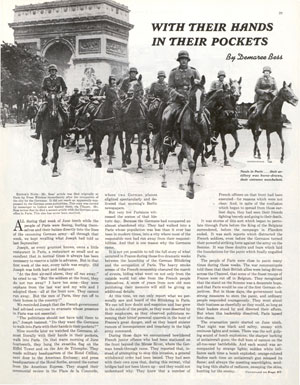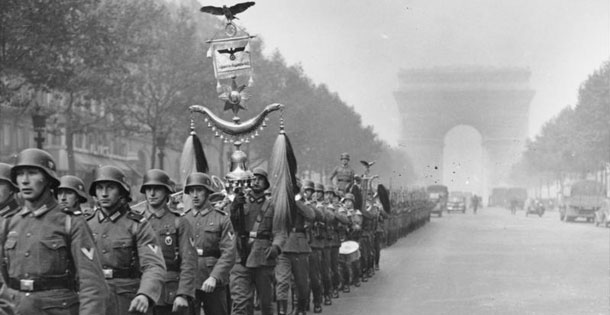
The news from Europe stunned America: On June 22, 1940, France surrendered to Germany.
Just six weeks earlier, Nazi Germany had sent its army into Holland and Belgium. In response, the French army moved north to meet the German advance, and British troops joined the fight. But by June 15, the Germans were marching into Paris. Six days later, the French government signed an armistice with the Nazis.
Americans wondered how this could be. They recalled how during the Great War 25 years earlier, France and Great Britain had stopped an invading German army. The two Allied forces pinned the Germans on a battle line 450 miles long for four years. And despite losing over a million soldiers, France ultimately defeated Germany.
But now, in this new war, Germany’s army pushed Britain’s army all the way back to the English Channel. The British only escaped capture when a hastily assembled fleet of 800 boats withdrew them to England.
Now alone, France struggled on, hoping to avoid the fate of Poland, Norway, Denmark, Luxembourg, Holland, and Belgium. But on June 22, France, too, surrendered to Germany.
In the U.S., the Nazi’s swift victory caused many to reconsider their neutrality. Dismissing the Nazi threat was easy when they presumed France and Great Britain would stop Hitler. But now, with France occupied, one less nation stood between the U.S. and Germany. Great Britain remained defiant and free, but many Americans thought the country had little chance of surviving.
So what had happened to the French?
Post contributor Demaree Bess was in Paris, looking for an explanation. He didn’t find many answers. He didn’t find many Parisians, either. The government fled the capital, along with much of the city’s population. In “With Their Hands in Their Pocket,” Bess describes his days in an eerily empty city awaiting the German conquerors.
Today, you can find several explanations for the French defeat. The most obvious, of course, is the German army, which spent 20 years preparing for the second great war.
When World War I ended, Germany was left with little food, rampant inflation, a government in chaos, and crippling penalties imposed by the Treaty of Versailles. In their grief and anger, many Germans found it easy to believe the myth that Germany had been betrayed by treacherous Germans. As Germans loudly demanded the right to re-arm their nation, the German military began secretly training the next generation of warriors. Given time, training, and weapons, Germany could return to France and defeat it.
Meanwhile, across the border in France, there was no interest in more war. The French found little pleasure in their victory, which they’d purchased at the cost of 1.3 million dead. The nation went back to work, but this proved difficult with so many men missing.
The French government in these years poorly served their citizens. Bitterly divided by political factions, France proved unable to develop an effective policy for national defense. However, it built a massive military structure in anticipation of the next war. It has become the symbol of narrow-minded planning.
It was the Maginot Line; a system of forts, bunkers, and observation posts along the border it shared with Germany. When completed, these hundreds of buildings were considered the most advanced fortifications ever built. France believed the line was impregnable; the country no longer needed to fear German invasion.
Unfortunately, the line left two entry points wide open. At its northern end, its defenses ended where the French border entered the Ardennes Forest. French authorities believed no defense was needed in this area because rivers, broken ground, dense woods, and winding roads made the Ardennes impassible to a modern, mechanized army.
Beyond the Ardenne lay the border with Belgium. The French didn’t extend the Maginot Line into this area because they had a mutual-defense treaty with the Belgians. If Germany invaded Belgium, the French army would cross the border to fight alongside their allies. But as war approached, Belgium declared its neutrality. Hastily, the French and British began extending the Maginot Line to the coast.
On May 10 as French and British troops rushed into Belgium to engage the Germans, another German army group, with a million men and 1,500 tanks, rolled through the impassable Ardennes Forest to strike at the rear of the Allies. The end came soon afterward.
Today some Americans firmly believe France was defeated because it simply did not defend itself. The French army, for the most part, simply surrendered when they saw the Germans. The accusation is conveniently revived whenever Franco-American relations turn hostile.
The problem with the French-didn’t-fight theory is that it doesn’t explain the 290,000 French soldiers who were killed or wounded in only six weeks of fighting.
Become a Saturday Evening Post member and enjoy unlimited access. Subscribe now



